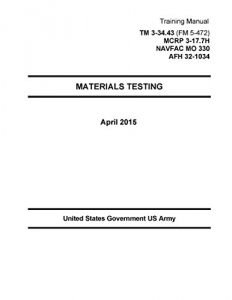Training Manual TM 3-34.43 (FM 5-472) MCRP 3-17.7H NAVFAC MO 330 AFH 32-1034 Materials Testing April 2015
Materials Testing provides the technical information necessary for military personnel to obtain samples and perform engineering tests and calculations on soils, bituminous paving mixtures, and concrete. These tests and calculations are required to achieve proper design with soils, bituminous paving mixtures, and concrete and to achieve adequate control over their use in military construction. This manual covers soils, aggregates, bituminous cements, bituminous paving mixtures, portland cement concrete, and stabilized soil, including stabilizing agents (bitumens, cements, lime, fly ash, chemical modifiers). It gives detailed instructions for taking adequate representative test samples and step-by-step procedures for making physical-properties tests and for recording, calculating, and evaluating test results. This manual explains methods for designing bituminous paving mixtures and stabilizing soil. It also gives the procedures and tests required to control the manufacturing of these mixtures. It describes the tools and equipment needed for performing tests and contains general instructions for the care, calibration, and use of test equipment.
This manual is adopted for use by the United States Marine Corps (USMC), United States Navy (USN), United States Air Force (USAF) personnel. Certain tests and procedures prescribed differ in principle or method and are more detailed than counterpart tests that are currently required by the U.S. Navy for new construction at Navy installations (including those in forward areas). The USMC engineer units perform field identification testing only. The USMC does not possess the tools or facilities required to perform the more deliberate laboratory tests described in parts of this publication.
The test procedures and terminology used in this manual conform to the latest methods and specifications of the American Society for Testing and Materials (ASTM), the American Concrete Institute, and the Portland Cement Association (PCA). The tests in this manual also apply to arctic construction. However, cold-weather effects present different problems and additional tests will be required for correct evaluation of the materials. These additional tests and considerations associated with arctic construction are in TM 5-349.
Materials Testing provides the technical information necessary for military personnel to obtain samples and perform engineering tests and calculations on soils, bituminous paving mixtures, and concrete. These tests and calculations are required to achieve proper design with soils, bituminous paving mixtures, and concrete and to achieve adequate control over their use in military construction. This manual covers soils, aggregates, bituminous cements, bituminous paving mixtures, portland cement concrete, and stabilized soil, including stabilizing agents (bitumens, cements, lime, fly ash, chemical modifiers). It gives detailed instructions for taking adequate representative test samples and step-by-step procedures for making physical-properties tests and for recording, calculating, and evaluating test results. This manual explains methods for designing bituminous paving mixtures and stabilizing soil. It also gives the procedures and tests required to control the manufacturing of these mixtures. It describes the tools and equipment needed for performing tests and contains general instructions for the care, calibration, and use of test equipment.
This manual is adopted for use by the United States Marine Corps (USMC), United States Navy (USN), United States Air Force (USAF) personnel. Certain tests and procedures prescribed differ in principle or method and are more detailed than counterpart tests that are currently required by the U.S. Navy for new construction at Navy installations (including those in forward areas). The USMC engineer units perform field identification testing only. The USMC does not possess the tools or facilities required to perform the more deliberate laboratory tests described in parts of this publication.
The test procedures and terminology used in this manual conform to the latest methods and specifications of the American Society for Testing and Materials (ASTM), the American Concrete Institute, and the Portland Cement Association (PCA). The tests in this manual also apply to arctic construction. However, cold-weather effects present different problems and additional tests will be required for correct evaluation of the materials. These additional tests and considerations associated with arctic construction are in TM 5-349.



